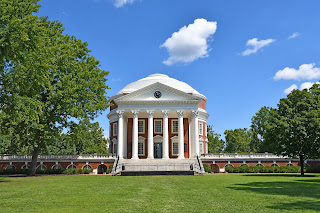Day 2: Monticello and the University of Virginia
Kelly and I agreed that we would start the day very early to beat the traffic around Washington. She set her alarm to five o’clock and I, still adjusting from European time, simply woke up at half past three and thanked my body for its obstinacy.
Since it
took some time for Kelly’s coffee to kick in, I did the driving for much of the
morning. Though we largely avoided DC rush-hour, I still found changing lanes
in the darkness and growing chaos somewhat stressful. By the time the skies
became blue, however, I felt confident enough to start driving with the music
turned on: we were passing by a place called Vienna, so I used my driver’s
prerogative to request waltzes and operetta classics (later on, once Kelly
figured out how to navigate my USB, I would be able to introduce her to my
carefully curated playlists of Armenian music, Zarzuelas, and American
classical music – some of them more topical to our trip than others. She, in
turn, shared with me her Broadway musicals, sea shanties, and country music).
We reached
Monticello in Virginia well before our 10:15 tour of the building. That was
quite fortunate, as my stomach started aching, and my mobility temporarily declined
to that of an eighty-year-old. Since I had shared yesterday’s mussels with
Kelly, I figured it was not food poisoning but my stomach trying to process
meat after a long time of eating no shellfish. Almost as unpleasant as the pain
was trying to smile and nod at the very well-meaning but talkative museum
staff.
Monticello
was built as a plantation and home by Thomas Jefferson, America’s third
president. Inspired by the time he spent as a diplomat in France, he borrowed
many of the house’s features from the old continent. The site was also home (and
effectively prison) to 150 enslaved labourers, who tended to the gardens and
house, and produced various goods. These included children, who served as nurses
and tended to the tobacco plantation until they were ten years old. The boys
would then go on to work at the nailery, while girls produced textiles. The
contrast between Jefferson’s purported ideals and actual treatment of enslaved
Africans and their descendants was, understandably, brought up by some of the
information panels (to varying degrees of success) as well as our tour guide.
Our next
stop was only a quarter of an hour away: we decided to have lunch in
Charlottesville, where we visited the University of Virginia Campus. Jefferson
believed the institution to be his magnus opus and persuaded his political
colleagues and allies to support the project. Interestingly, he was very
insistent on the university’s secularism. He elected to build a rotunda at its
core rather than a church, and the university never named a professor of
theology. He also wanted the university to provide what has come to be known as
“liberal education.”
Being an
idiot, I ate lunch very quickly and upset my stomach again. I was not as big of
an idiot as one driver we saw at the traffic lights, though. The man kept
inching forward until he shattered the glass of the car in front of him. It was
the first traffic accident I had ever seen happen in real time.
It was in
Virginia that the landscape finally started changing from the flat monotony of
the Mid-Atlantic coast. Every now and then, the blue silhouettes of the
Appalachians emerged from behind a forest. We would ascend the mountains that same
evening as we drove towards Asheville. The climate there was cooler, and the
air felt cleaner than before.
We ate
dinner in Asheville with a Winterthur friend of Kelly’s, who brought her dog.
After that, the three of us walked around the neighbourhood, allowing us to
appreciate the laidback tempo of the town and the fresh evening breeze.
We drove
523 miles today, bringing our total up to 618.





















Comments
Post a Comment